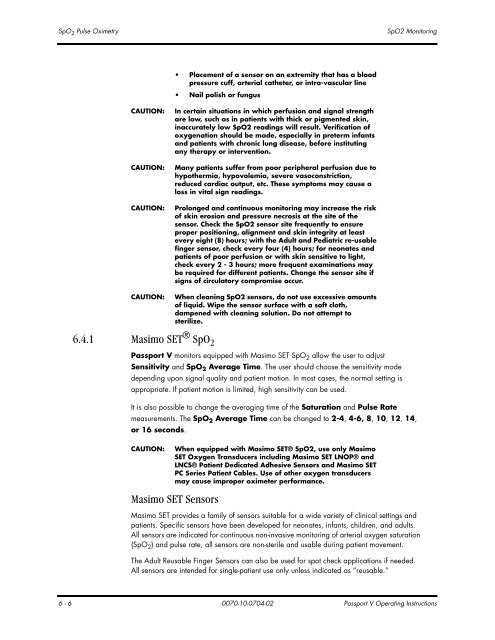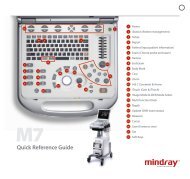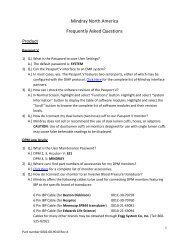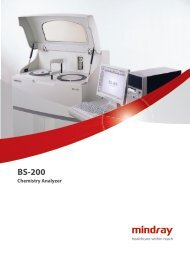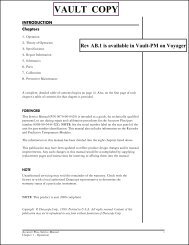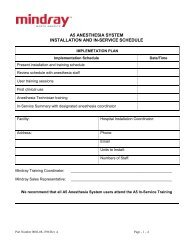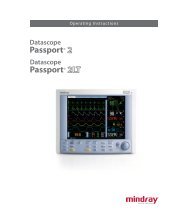Passport® - Mindray
Passport® - Mindray
Passport® - Mindray
- TAGS
- mindray
- res.mindray.com
You also want an ePaper? Increase the reach of your titles
YUMPU automatically turns print PDFs into web optimized ePapers that Google loves.
SpO 2 Pulse Oximetry SpO2 Monitoring<br />
Placement of a sensor on an extremity that has a blood<br />
pressure cuff, arterial catheter, or intra-vascular line<br />
Nail polish or fungus<br />
CAUTION: In certain situations in which perfusion and signal strength<br />
are low, such as in patients with thick or pigmented skin,<br />
inaccurately low SpO2 readings will result. Verification of<br />
oxygenation should be made, especially in preterm infants<br />
and patients with chronic lung disease, before instituting<br />
any therapy or intervention.<br />
CAUTION: Many patients suffer from poor peripheral perfusion due to<br />
hypothermia, hypovolemia, severe vasoconstriction,<br />
reduced cardiac output, etc. These symptoms may cause a<br />
loss in vital sign readings.<br />
CAUTION: Prolonged and continuous monitoring may increase the risk<br />
of skin erosion and pressure necrosis at the site of the<br />
sensor. Check the SpO2 sensor site frequently to ensure<br />
proper positioning, alignment and skin integrity at least<br />
every eight (8) hours; with the Adult and Pediatric re-usable<br />
finger sensor, check every four (4) hours; for neonates and<br />
patients of poor perfusion or with skin sensitive to light,<br />
check every 2 - 3 hours; more frequent examinations may<br />
be required for different patients. Change the sensor site if<br />
signs of circulatory compromise occur.<br />
CAUTION: When cleaning SpO2 sensors, do not use excessive amounts<br />
of liquid. Wipe the sensor surface with a soft cloth,<br />
dampened with cleaning solution. Do not attempt to<br />
sterilize.<br />
6.4.1 Masimo SET ® SpO 2<br />
Passport V monitors equipped with Masimo SET SpO2 allow the user to adjust<br />
Sensitivity and SpO2 Average Time. The user should choose the sensitivity mode<br />
depending upon signal quality and patient motion. In most cases, the normal setting is<br />
appropriate. If patient motion is limited, high sensitivity can be used.<br />
It is also possible to change the averaging time of the Saturation and Pulse Rate<br />
measurements. The SpO2 Average Time can be changed to 2-4, 4-6, 8, 10, 12, 14,<br />
or 16 seconds.<br />
CAUTION: When equipped with Masimo SET® SpO2, use only Masimo<br />
SET Oxygen Transducers including Masimo SET LNOP® and<br />
LNCS® Patient Dedicated Adhesive Sensors and Masimo SET<br />
PC Series Patient Cables. Use of other oxygen transducers<br />
may cause improper oximeter performance.<br />
Masimo SET Sensors<br />
Masimo SET provides a family of sensors suitable for a wide variety of clinical settings and<br />
patients. Specific sensors have been developed for neonates, infants, children, and adults.<br />
All sensors are indicated for continuous non-invasive monitoring of arterial oxygen saturation<br />
(SpO 2) and pulse rate, all sensors are non-sterile and usable during patient movement.<br />
The Adult Reusable Finger Sensors can also be used for spot check applications if needed.<br />
All sensors are intended for single-patient use only unless indicated as “reusable.”<br />
6 - 6 0070-10-0704-02 Passport V Operating Instructions


